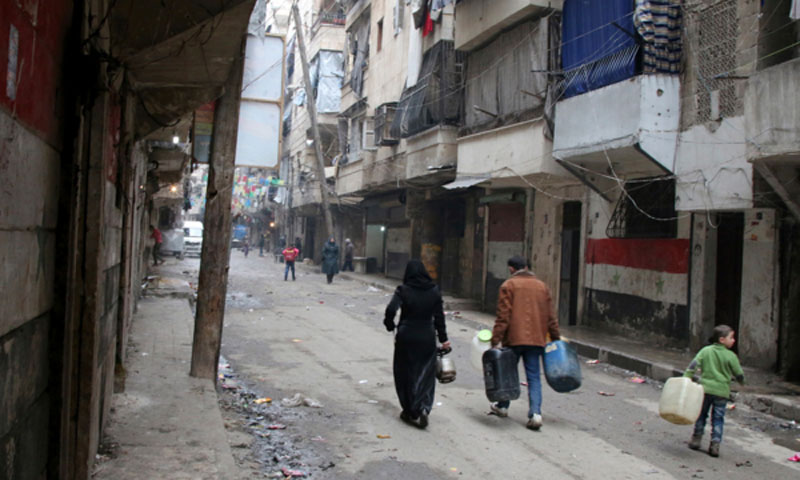“My salary is just ABOUT 30,000 Syrian Liras, the water tank costs 2500 Liras and the electricity ampere two thousands … How can I afford a living?” thus wonders “R.S “, a government employee at the University of Aleppo, about the challenging reality she has to face now as she is incapable to afford basic services.
The city of Aleppo has been suffering from the irregular distribution of “governmental” services such as electricity and water for more than four years. The problem is still there, and officials are still offering nothing but false promises even after the regime regained control of the eastern neighborhoods by the end of last year.
With the rising temperatures and the services interruptions during Ramadan and in Eid al-Fitr, an anger storm and a general state of discontent blew through social media.
The local social media pages instantaneously reported the interruptions and tried to understand the reasons behind the “crisis” by pointing the finger at the electricity and water companies and debunking official claims that attributed the interruptions to simple “technical failures.”
No washing machine and no fridge
Aleppo has started to suffer with electricity when the electric thermal power station of the city went out of service on November 7, 2013, located 25 kilometers from the city on the Aleppo – Raqqa road.
The station is considered to be the biggest power plant in Syria. It consists of five steam generators with a capacity of 213 MW each, and it provides the national electrical grid with about 20% of the total energy generated in the country, according to official statistics the “SANA” agency reported.
Nothing was left then to the people of Aleppo but to accept the necessary evil and “forcefully” resort to buying “Amperes” from huge electricity generators owned by dealers. The price of a single ampere is currently about 2500 Syrian Liras. One family presumably consumes at least one or two amperes, depending on how ready they are to use electric appliances such as washing machines, fridges, etc. at home.
“R.S” said in this context that “in case the family could not afford that, it will do without a fridge and a washing machine. These have become mere luxury for so many people who are simply satisfied with lighting and charging phones.”
Same Old Explanations for the Same Odd Failures!
The Ministry of Electricity has recently announced it started to prepare the materials, equipment, work supplies and qualified human cadres needed for the rehabilitation of Aleppo electric thermal power station in February 2016.
However, oddly enough, Aleppo is still without electricity. One of the citzens, Hassan, says: “The city is listening to the same old tune they keep playing about technical failures. Whenever they put on the refrain saying they have fixed it, electricity goes off after just one hour.”
Ali Baba and the Forty Thieves
The citizens whom Enab Baladi interviewed have doubts concerning some hidden agreements or plans that might exist between government officials and electricity generators owners. According to the university employee, “every dealer has a government-employed partner who protects him and shares profits with him… following the ‘Ali Baba and the forty thieves’ principle.”
This is what was confirmed by Hassan, “The money jumps out of a civilian’s pocket to land in the pocket of a government official, no intruders allowed”
Pay me a Visit Once a Year
As for the water crisis, which the city has been suffering from for nearly two years, citizens rely on (portable) “water tanks” to be filled in stations that are available around the city. The owners of these water tanks divide the city into territories so as to provide each zone with the water quantity it needs.
The price of a “container” (1,000 liters) is between 1,000 and 4,000 Syrian Liras, depending on the area and water scarcity in it. A small family that consists of 3 or 4 members needs one container per week.
The “governmental” water line, however, provides water for the city houses once or twice a month and for just a few hours, depending on the capacity of the main supply line, in addition to an alternating line during the failure period, but with a lower efficiency and an even lower pumping capacity.
But in case there is failure in the supply line, the water is not pumped, and therefore the region will be deprived of its monthly share, just like what the popular song “Pay me a Visit Once a Year” says, according to “R. S”.
“Thirsty Aleppo”
Al-Zahraa Neighborhood News Network in Aleppo, that supports the Syrian regime, pointed the finger at those whom it considered as “corrupt” government officials for the continuous water and electricity distribution interruptions. It pointed out that “They invented the story of line 1400 reparations, which is the main supply line east of Al-Zahra neighborhood, where they installed technical workshops wherever they spotted failure, but they have actually fixed nothing.”
The usual explanation officials give is that of the lines being targeted by “militants”, but the news network has made it clear that the area of the 1400 line has not witnessed any manifest conflict for more than four months, and that the line is about five meters under the ground, which makes it practically indestructible in a normal fight.
There was a wide range of reactions among the citizens in social media that were reflected through the two hashtags “#Thirsty Aleppo” and “#Afflicted Aleppo” expressing their discontent as to how they have to pay two thirds of their salaries at least to have access to basic services, while the government is turning a blind eye on the problem.”

